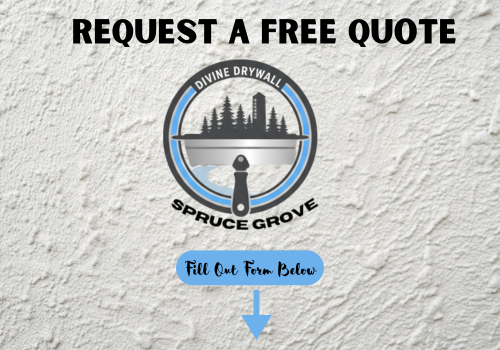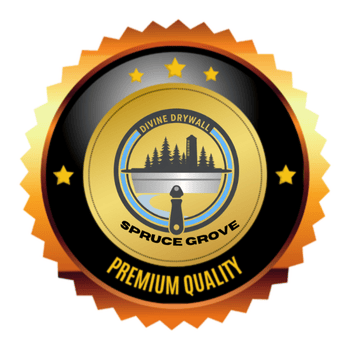Flood Cut & Rebuild in Spruce Grove, AB
When water enters your home, Divine Drywall Spruce Grove delivers fast, reliable flood cut and rebuild services throughout Spruce Grove, AB. Our team restores damaged walls with precision, removing compromised materials and rebuilding with methods that stand up to Alberta’s climate. We help homeowners regain safety, structure, and peace of mind after water intrusion.
Flood damage rarely stops at the surface, which is why our approach goes deeper than basic tear-outs. We use moisture meters, setting compounds, and proper patch backing to remove saturated sections below the flood line and eliminate hidden risks like mould inside wall cavities. By pairing skilled craftsmanship with clean, code-aligned rebuilding techniques, we ensure every repaired section ties seamlessly into your existing structure.
If you need fast, dependable restoration, call now for priority service. For broader drywall solutions in the area, visit our drywall repair services page.

Divine Drywall Spruce Grove (SP)

Essential Steps in Flood Cut and Rebuild
Professional flood restoration requires systematic water damage assessment, precise cutting techniques to remove compromised materials, thorough moisture elimination, and safe disposal of contaminated components. Each step builds toward complete structural recovery and prevents long-term damage.
Initial Water Damage Assessment
Your contractor begins by documenting the full extent of water penetration using moisture meters and thermal imaging cameras. This assessment identifies affected areas beyond what's visible to determine the scope of flood cut work needed.
Critical measurements include:
- Water line height on walls
- Moisture content in drywall and insulation
- Structural material saturation levels
- Hidden moisture behind baseboards
The assessment determines whether flood cuts should extend 12 to 24 inches above the water line. Your Spruce Grove contractor maps contaminated zones to establish safe removal boundaries.
Professional documentation at this stage supports insurance claims. Photographs and moisture readings create a baseline for restoration progress tracking.
Flood Cut Techniques for Wet Wall Remediation
Flood cutting involves removing drywall from floor level up to a predetermined height above water damage. Your contractor uses reciprocating saws or utility knives to create clean, horizontal cuts.
The standard approach removes drywall 12-24 inches above the highest water mark. This ensures complete elimination of wicking moisture that travels upward through porous materials.
Proper technique requires:
- Straight, level cuts across wall surfaces
- Complete baseboard and trim removal
- Careful cutting around electrical outlets
- Protection of undamaged areas above cut line
Your contractor removes both sides of interior walls when water penetrated through. Exterior walls may require interior-only removal depending on moisture penetration depth.
Clean cuts prepare walls for accurate rebuilding once drying is complete.
Moisture Removal and Structural Drying
Industrial dehumidifiers and air movers create controlled drying conditions after flood cutting. Your contractor monitors humidity levels and surface moisture content daily until readings reach acceptable standards.
Equipment typically includes:
- High-capacity dehumidifiers for air moisture control
- Air movers positioned to maximize airflow
- Moisture meters for progress monitoring
- Temperature controls to optimize drying rates
Structural drying takes 3-7 days depending on material thickness and initial saturation levels. Your Spruce Grove contractor adjusts equipment placement as moisture levels decrease.
Proper drying prevents mold growth and ensures stable conditions for rebuilding. Documentation proves materials have reached industry-standard dryness before reconstruction begins.
Contaminated Material Removal
All flood-damaged materials require safe removal and disposal according to local regulations. Your contractor separates materials by contamination level and disposal requirements.
Category 3 water damage (sewage or outdoor flooding) requires complete removal of porous materials including insulation, carpet padding, and lower wall sections.
Materials requiring removal:
- Saturated drywall and insulation
- Contaminated baseboards and trim
- Damaged vapor barriers
- Flooring materials below grade
Your contractor bags contaminated materials separately from general construction debris. Proper disposal prevents cross-contamination during the removal process.
HEPA filtration during removal contains airborne particles. Work areas are isolated to prevent contamination spread throughout your property.
Comprehensive Water Damage Repair and Restoration Solutions
Water damage restoration requires systematic removal of contaminated materials and complete reconstruction of affected building components. Each element from drywall to vapor barriers must be properly assessed, removed, and rebuilt to prevent future moisture problems.
Drywall Replacement and Wall Tear-Out
Water-damaged drywall loses structural integrity and becomes a breeding ground for mold growth. Your drywall must be cut and removed at least 12 inches above the waterline to ensure all contaminated material is eliminated.
The tear-out process involves cutting precise horizontal lines across affected walls. This flood cut method removes the damaged lower portion while preserving unaffected areas above.
Standard flood cut heights:
- Minor water damage: 12-18 inches above waterline
- Moderate flooding: 24-36 inches above waterline
- Severe flooding: Full wall replacement required
Your builder will use moisture meters to determine exact cut lines. Hidden moisture behind drywall can extend well beyond visible damage areas.
New drywall installation requires proper fastening to existing studs. Seams must be taped, mudded, and sanded to match existing wall texture before priming and painting.
Vapor Barrier and Insulation Replacement
Wet insulation loses its thermal properties and retains moisture indefinitely. Your insulation must be completely removed and replaced after flood damage occurs.
Fiberglass and cellulose insulation cannot be dried effectively once saturated. These materials compress when wet and never return to their original thickness or R-value.
Insulation replacement steps:
- Remove all wet insulation materials
- Clean and disinfect wall cavities
- Allow complete drying of framing lumber
- Install new vapor barrier
- Install fresh insulation to proper R-value
Your vapor barrier prevents moisture migration through wall assemblies. Damaged barriers allow humidity to penetrate insulation and cause ongoing problems.
In Spruce Grove's climate, proper vapor barrier installation is essential. The barrier must be continuous with sealed joints and penetrations.
Trim and Baseboard Rebuild
Baseboards and door casings absorb water rapidly through their bottom edges. Most trim materials cannot be salvaged after flood exposure.
Wooden trim swells, warps, and develops mold growth within 24-48 hours. Your trim must be removed before drywall installation begins.
Trim removal process:
- Score caulk lines with utility knife
- Pry trim carefully to avoid wall damage
- Remove all nails and fasteners
- Clean mounting surfaces thoroughly
New trim installation requires precise measurements and proper fastening. Your builder will match existing profiles and wood species when possible.
Priming all trim surfaces before installation prevents future moisture absorption. Caulking at floor and ceiling joints creates moisture barriers.
Wall Reconstruction
Complete wall reconstruction becomes necessary when structural framing sustains damage. Your wall studs and plates require inspection for integrity and moisture content.
Lumber moisture levels must drop below 19% before reconstruction begins. Elevated moisture readings indicate continued drying time is needed.
Reconstruction sequence:
- Frame inspection and moisture testing
- Structural repairs to damaged lumber
- Vapor barrier installation
- Insulation placement
- Drywall hanging and finishing
Your electrical and plumbing systems require inspection before closing walls. Flood water can damage wiring and create safety hazards.
Wall reconstruction in Spruce Grove must meet current building codes. Your builder ensures all work complies with Alberta construction standards and local requirements.
Advanced Post-Flood Restoration and Emergency Services
Professional flood restoration requires immediate emergency response and comprehensive property restoration planning to prevent long-term structural damage. Proper moisture removal, contaminated material handling, and future damage mitigation protect your Spruce Grove property investment.
Emergency Water Damage Services
24/7 Response Protocol Emergency water damage services begin within hours of your call to prevent secondary damage like mold growth and structural deterioration. Divine Drywall Spruce Grove responds immediately to assess flood damage severity and begin water extraction.
Critical First Steps
- Water extraction and removal
- Structural drying with industrial equipment
- Moisture level monitoring and documentation
- Contaminated material identification
Professional Equipment Deployment High-powered dehumidifiers and air movers create optimal drying conditions in your flooded spaces. Moisture meters track progress to ensure complete drying before reconstruction begins.
Safety Considerations Electrical systems require immediate inspection before any restoration work starts. Your contractor evaluates structural integrity to determine safe working conditions and access points.
Property Restoration Planning
Comprehensive Damage Assessment Professional restoration planning starts with detailed documentation of all affected areas, materials, and systems. Your Spruce Grove contractor creates a restoration timeline based on drying requirements and material availability.
Material Replacement Strategy
Component Replacement Timeline Special Considerations
Drywall 3-5 days post-drying Moisture content verification
Insulation Immediate removal Contamination assessment
Flooring 5-7 days post-drying Subfloor moisture testing
Coordination Requirements Multiple trades work in sequence during restoration. Drying specialists complete their work before drywall installation begins.
Code Compliance All restoration work must meet current building codes and permit requirements. Your contractor handles inspection scheduling and compliance documentation throughout the rebuild process.
Mitigating Future Water Damage
Structural Improvements Post-flood reconstruction offers opportunities to upgrade water-resistant materials and improve drainage systems. Installing vapor barriers and moisture-resistant insulation reduces future flood impact.
Preventive Measures
- Sump pump installation or upgrades
- Foundation waterproofing improvements
- Proper grading around your property
- Window well drainage enhancements
Material Selection Choose flood-resistant materials for basement and ground-level areas. Moisture-resistant drywall and treated lumber provide better protection during future water events.
Monitoring Systems Water detection alarms and humidity monitors provide early warning of moisture problems. These systems alert you to potential issues before major damage occurs.
